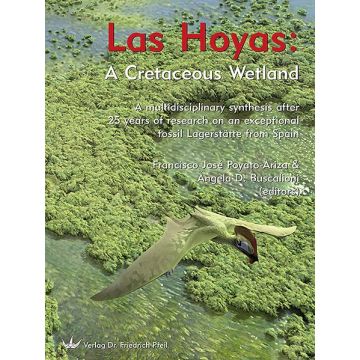Poyato-Ariza Francisco Jose, Angela D. Buscalioni (Hg.) - Las Hoyas: A Cretaceous Wetland
A multidisciplinary synthesis after 25 years of research on an exceptional fossil Lagerstätte from Spain

Tags
At human scale, 25 years seems time enough to relate academic and scientific experiences. The particular experiences presented in this book are based, first of all, on the earliest works and research at Las Hoyas led by Prof. José Luis Sanz. This book honors him as a tribute to those early years of Las Hoyas, where, while admiring the beauty of its fossils, we all learned the huge diversity of Nature and, at the same time, how to handle a number of enthusiastic students, manage the collection, and ask for funds year after year. The best of what we have all learnt from Prof. Sanz is the importance of a work that is properly done, and this sort of obsession will hound us forever.
Much or little was made in these 25 years, depending on how one looks at it. Either way, this synthesis volume aims to convey the story of our experience in the study of Las Hoyas. The present book is aimed to both specialists and informed aficionados. It incorporates many international researchers who have largely contributed to the understanding of the palaeobiology and taphonomy of this locality. The volume is organized into four major parts. Part I is devoted to the Las Hoyas environment by providing the geological framework to understand how the interpretation of this fossil Lagerstätte has changed from a deep lake at first to the current hypothesis of a shallow aquatic environment made of a mosaic of pools, filled by microbial mats, in a wetland-like landscape. Part II unfolds the palaeobiology of the different groups of plants and animals recorded at Las Hoyas by providing an updated revision of their taxonomic diversity. The information provided for each group is presented in a homogeneous manner by developing a summarized description of the specimens, their life styles and ecomorphology, phylogenetic context, preservation, and relevance of the Las Hoyas record within a worldwide or European frame. The processes involved in the fossil preservation are explored in Part III. This part includes not only the study of the preservation of the fossils themselves, but also some chapters devoted to experimental taphonomy and the role of microbial mats in preservation. Part IV incorporates our experience in the fieldwork in establishing how palaeoecological restorations need of a previous taphonomic study. The final chapter presents restorations by some brilliant young artists of the landscape and organisms living in the Las Hoyas Wetland during the Early Cretaceous in the framework of their trophic network. An Addendum incorporates taxa discovered or described during the elaboration of the present volume, and a final Appendix presents an updated taxonomic classification of the biota from Las Hoyas.
We wish to emphasize the idea that Las Hoyas is a laboratory of Natural History where new questions are continuously emerging: How was the site generated? What conditions were present, resulting on such abundance and exceptional preservation? What were the modes of life of those extinct organisms? What relevance has it all from an evolutionary point of view? Knowledge of the past does not always involve explaining the future, but sets the way in which it originated and shaped the present. Fossils will always be the key to unveil the History of Life on Earth.
Verlag:
Medienart:
Bücher
Sprache:
Englisch
EAN:
9783899371536
Höhe in mm:
326
Breite in mm:
245
Erscheinungsjahr:
2016
Kategorien: Naturführer
Schreibe deine eigene Bewertung
Noch keine Herstellerangaben und Sicherheitshinweise verfügbar.